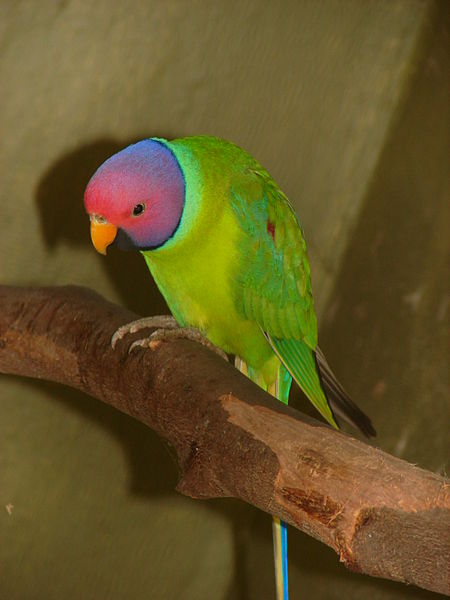 The gorgeous Plum-Headed Parakeet, Psittacula cyanocephala, combines “exotic” beauty with extreme hardiness. Active and inquisitive, yet possessed of a calm disposition, this South Asian native makes a wonderful pet or aviary addition.
The gorgeous Plum-Headed Parakeet, Psittacula cyanocephala, combines “exotic” beauty with extreme hardiness. Active and inquisitive, yet possessed of a calm disposition, this South Asian native makes a wonderful pet or aviary addition.
Description
A slender tail comprises over two-thirds of the Plum-Headed Parakeet’s 14 inch length. The male’s colorful head, which is clad in mixed shades of red, purple, maroon, violet, rose and/or pink, lends the species its common name. Females lack the black neck ring and have an attractive bluish-gray head. The body plumage of both sexes is a beautiful blend of lime and other shades of green.
Albino, green, blue and lutino mutations have been produced by hobbyists.
Range
The Plum-Headed Parakeet ranges from western Pakistan through most of India to Sri Lankain the south and Nepal and Bhutan in the north.
Habitat
Plum-Headed Parakeets favor forest edges, wooded plains and other semi-open habitats. Often common in woodlots near farms, they are considered agricultural pests in some regions.
Plum-Headed Parakeets as Pets
 Most owners describe their Plum-Headed Parakeets as “moderately quiet”, but individual birds vary a great deal in this regard. They may learn a few words, but are known more for whistling than for their speaking abilities.
Most owners describe their Plum-Headed Parakeets as “moderately quiet”, but individual birds vary a great deal in this regard. They may learn a few words, but are known more for whistling than for their speaking abilities.
Plum-Headed Parakeets tend to be shy, but in time can become very trusting of their owners. However, most do not enjoy handling and rough-housing as might, for example, a tame cockatoo.
Housing
These birds love to climb and are very skilled, graceful fliers (wild flocks are described as shooting though heavy cover without ruffling a leaf). They are therefore best housed in outdoor or indoor aviaries, where they will remain active and interested in their environment. While Plum- Headed Parakeets will adjust to life in a large cage, they tend to become lethargic if not provided with daily out-of-cage exercise time.
Despite their “tropical colors”, Plum-Headed Parakeets often inhabit high altitude environments and are well adapted to cool temperatures. Year-round outdoor housing is often possible if a heated shelter is provided. The closely-related Indian Ring-Necked Parakeet has even established a small breeding population in NYC…during my years at the Bronx Zoo I kept tabs on a small flock, and was amazed to see how well they weathered the frigid winters (please see article below).
Generally mild-mannered, they get along well in groups and with Java Rice Birds, Chinese Quail, larger finches and similar birds. Breeding pairs are best kept alone.
Diet
Wild Plum-Headed Parakeets consume a highly varied diet and captives fare best with the same. A good small parrot blend can comprise the bulk of your pet’s food, but sprouts, chopped fruit, and greens such as kale, dandelion and chicory should also be provided daily.
Branches from budding apple, pear, peach and other fruit trees are especially favored, and will keep parakeets occupied for hours.
Breeding
Plum-Headed Parrots regularly reproduce in captivity, but are not considered “easy breeders”. The best results will be had by housing a pair alone in an outdoor aviary.
A female will typically produce 4-6 eggs which she alone will incubate for 21-24 days. The male feeds her during this time, and he is also largely responsible for feeding the chicks once they fledge (at age 6 weeks). Interestingly, the female may remain in the nest for up to 3 weeks after the chicks have fledged – apparently feeling that “enough is enough”! The male will continue to feed her during this “recuperation period”.
 Pairs on the nest rarely develop the aggressive tendencies shown by many other breeding parrots. Rather, Plum-Headed Parakeets often abandon rather than defend their nests if stressed. For that reason, active nests should not be inspected.
Pairs on the nest rarely develop the aggressive tendencies shown by many other breeding parrots. Rather, Plum-Headed Parakeets often abandon rather than defend their nests if stressed. For that reason, active nests should not be inspected.
Further Reading
Nice to see out the classroom window: Survey of Plum Headed Parakeets and other birds on a college campus in India
Video: Pair of wild Plum Headed Parakeets grooming
Ring Necked Parakeets in NYC; Captive Care
Plum-headed Parakeet with fish image referenced from wikipedia and originally posted by Nevit Dilmen
Plum-headed Parakeet with fish image referenced from wikipedia and originally posted by Quartl
Plum-headed Parakeet with fish image referenced from wikipedia and originally posted by J.M. Garg
 That Bird Blog – Bird Care and History for Pet Birds
That Bird Blog – Bird Care and History for Pet Birds




I breed Plum Heads and you posted the most correct of articles I have read. I have seen a lot of miss leading articles out there and you are very right saying they do not like their nest bothered and breeding is done better with isolated pairs in large enclosures. They should be fed a very wide selections of fruits, vegetables, brown rice, puffed rice and red wheat, greens, and porteins at all times with very fresh water all the time. I use both bowl and bottle for watering they like to soften their food in water while feed their babies. I wish I could find another breeder in Texas to exchange babies so I could multiply my breeding stock.
Very kind of you to write in Tracy, thank you.
Unfortunately I do not have any contacts in Texas, but will keep an eye out. Please check in when you can, Enjoy, best, Frank